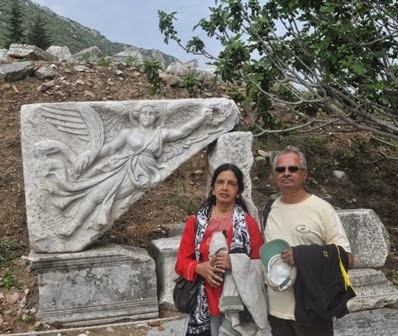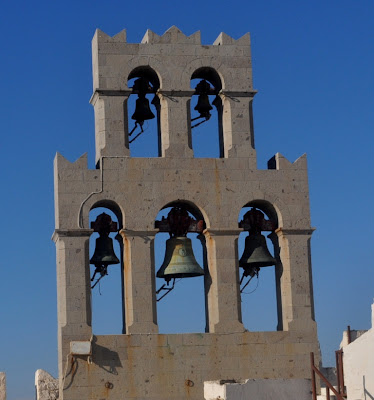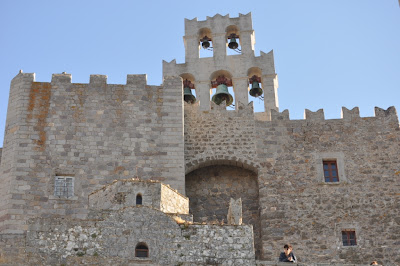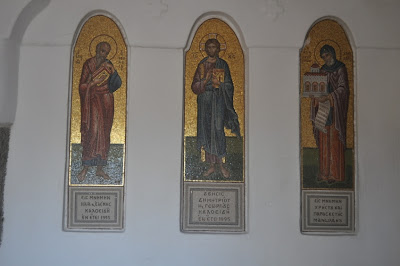Early
morning on 11th May 2013, we left Kusadasi, our last halt in Turkey,
for the Aegean sea cruise. We had to clear customs and immigration as the ship
will be cruising in Greek waters.
We
boarded LOIUIS OLYMPIA, the cruise ship around 10 am. The ship has 7 decks. We
were allotted a cabin on the 3rd deck, an inner state room, probably
the cheapest. The restaurants are on the
4th floor, conference room etc. on the 5th deck. There were swimming
pools, casino, ball room on the 6th deck. There were about 750
passengers and more than that number of crew.
All
those who embarked at Kusadasi were given fire and life boat escape drills before
the ship set sailed. We left Kusadasi at 12 noon and reached Patmos around 4pm.
The ship anchored some distance from the shore. We were transported to the
island by tender boats with a capacity of about 100. The cruise ship organizes land
trips in Patmos at 48 Euros per head. We wanted to explore on our own.
On
landing we were joined by another couple from Chennai and together we hired a
cab for 30 Euros for 2 hours, for going around the island of Patmos.
Patmos is a small Greek island in
the Aegean Sea.
Patmos
is mentioned in the Christian Book of Revelations.
The book states that its author, John, was in a cave on Patmos when he was given a vision
from Jesus. The cave where
John is said to have received his Revelation (the Cave of the Apocalypse) is half way up the hill. This was our first halt. This
is a very small cave in which there is now a chapel. The cave is formed in
volcanic rock. To the right there
is the sacred cave and church of Saint John the Divine. In the centre between
the cave and the chapel the low rock ceiling reaches out in clear threefold
split, said to be the sign of the Holy Trinity.
At the back of the cave there is a fenced off
section where a niche in the rock shows where the saint laid his head to rest.
To the left if you look closely you will see a relief of a Greek cross that
locals believe was not done by human hands. This is why this place is also
called The
Jerusalem of the Aegean.
We
then proceeded to the top of the hill where there are several monasteries dedicated to Saint John.
Monastery of John the Baptist.
After the
death of John of Patmos, possibly around 100, a number of Early Christian basilicas were erected on Patmos. Among these
was a Grand Royal Basilica in honour of Saint John, built c. 300-350 at the
location where the Monastery of John the Baptist stands
today. Buildings of different ages form the
Monastery, comprising 10 chapels and 99 cells as well as a Library of 890
handwritten codes and 13,000 documents about the history of the site.
The
monastery’s walls are over 15 meters high, its length from north to south is 53
meters and from east to west 70 meters. It seems even larger when you stand at
the entrance, noticing its thick walls and heavily reinforced door.
The monks used to sound the bells to warn the people of Patmos to take refuge behind the fortified walls of the monastery, keeping Christianity safe.
The monks used to sound the bells to warn the people of Patmos to take refuge behind the fortified walls of the monastery, keeping Christianity safe.
As you enter the courtyard
you see a round covered structure looking like a well. However it is learnt
that is a wine storage.
Across the main courtyard on the first floor, is
the old bakery, where the remains of a huge stone oven can be seen and a long
wooden trough where the monks used to kneed their bread. Behind the chapel of
The Virgin Mary is the refectory where the monks ate their meals together. It
is a rectangular room about 50 square meters and 8 meters high, there are two
long tables covered with marble. There are niches in them where monks placed
their personal items and beautiful frescos and wall paintings dating back to
1180.
The Blessed
Christodoulos also founded the monastery library. When he arrived on the island
he brought with him his personal library including manuscripts from the
monastic area of Mt. Latmos. The library is now home now to more than 3000
printed books, 900 manuscripts and 13000 documents dating back to 1073.This
room is not open to the public except by special permission.
Inside the monastery are the skull
of St Thomas, pieces of the Holy Cross and other religious relics.There are excellent wall paintings in this room. No
words could sufficiently describe their beauty.
It took us about 2 hours to see the cave and the
Monastery. There is an entrance fee of 4 Euros at the cave and 8 Euros at the
monastery. We came back to the dock. As usual in any tourist place, along the
water front there are a large number of cafes, shops selling curios, clothes
etc. We suddenly realized that we were in not in Turkey but in a different
country when we had to pay in Euros and not Liras.
We got into the tender boat and went back to the
cruise ship to start for our next destination.



















No comments:
Post a Comment